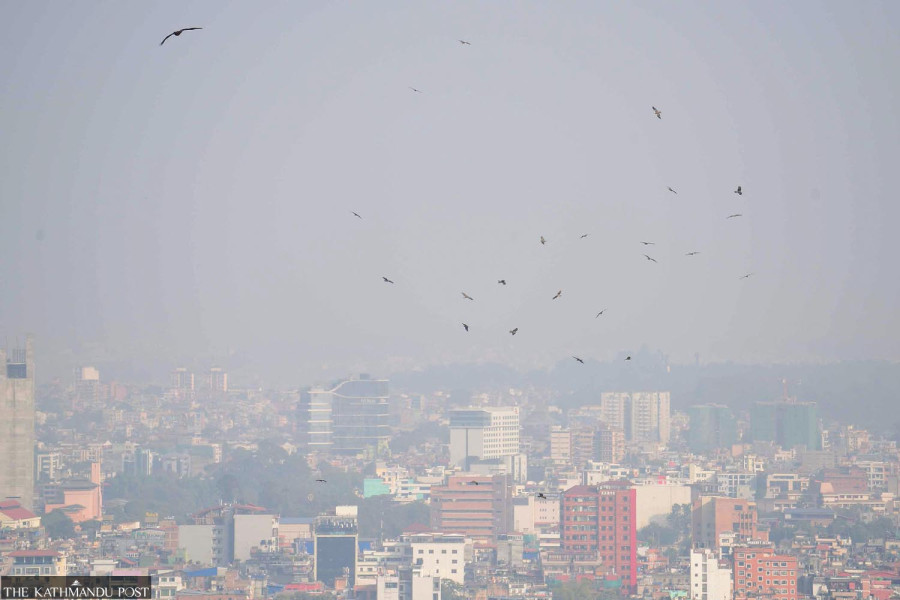Climate & Environment
Road fumes and construction dust driving Nepal’s air quality decline
Studies show polluted air is shortening Nepali lives by almost five years.
Arjun Poudel
A few days ago, a 65-year-old woman from Gwarko, Lalitpur, where a flyover is under construction, was rushed to a private clinic as she complained of shortness of breath and dizziness. Doctors found her oxygen level had dropped to 40, a critical stage in which a patient needs supplemental oxygen via a tube and mask.
“The patient was brought in a critical condition. She was suffering from asthma,” said Dr Dirgha Singh Bam, a senior chest physician who is also a former secretary at the Ministry of Health. “Pollution from the road and the flyover construction site not only made her sick but is also harming younger members of her family and others in the area.”
Air quality is once again worsening in the Kathmandu Valley and other places. Experts say the burning of stubble and agricultural waste, along with dust from roads and construction sites are the main culprits. Besides these, polluted air from India could be equally responsible, according to them.
“Whatever the causes, toxic air is taking a huge toll on public health, and the agencies concerned are doing little to address it,” said Dr Bam. “Every year during the dry season, air quality plummets to hazardous levels, but we have stopped complaining about it. Also, we have stopped expecting accountability from the agencies concerned.”
On Wednesday, air quality in the Kathmandu Valley worsened to unhealthy levels. According to IQ AirVisual, a Swiss group that collects air-quality data from around the world, Kathmandu ranked as the sixth most-polluted city in the world with PM2.5 levels reaching 189 micrograms per cubic metre (μg/m3) on Wednesday morning.
Meghauli of Chitwan recorded even higher levels at 207 micrograms per cubic metre (μg/m3), which is considered ‘very unhealthy’.
PM2.5 refers to particulate matter (solid or liquid droplets) in the air that is less than 2.5 micrometres in diameter. It is among the most dangerous pollutants that can get past the nose and throat to penetrate the lungs and even the bloodstream. PM2.5 particles are small and are also likely to stay suspended in the air for long, increasing the chances of people inhaling them.
As per the Environmental Protection Agency’s air quality index, it is considered unhealthy when air quality reaches 151–200, everyone may experience problems, with sensitive groups feeling more severe effects.
Although air quality declines during winter and dry seasons are common, experts criticise the inaction of the agencies responsible for addressing the problem. They say polluted air affects not only the elderly people and those already suffering from respiratory illnesses, but also young people and children.
“Unless the public starts holding the responsible agencies accountable, this problem will remain,” said Dr Arjun Karki, chief consultant and head of pulmonary critical care at Hams Hospital. “Many sensitive issues that affect everyone are overshadowed by less-important political issues. Media, too, are busy diverting public attention to trivial matters.”
Construction activities, especially those involving roads and sidewalks, are major sources of dust pollution. Most of these projects start only after the dry season begins, and are left incomplete for a long time. Contractors dig up roads without any urgency to meet deadlines.
“A lack of coordination between the agencies concerned makes matters worse,” said Bam. “There are dozens of examples of projects not being completed on time, and people are left to bear the brunt of the authorities’ negligence—whether it is the Butwal-Narayanghat road construction project or other smaller projects. I have advised some patients to move to less polluted areas.”
Doctors say the deterioration of air quality seriously affects public health. According to them, poor air quality causes both short- and long-term effects on public health. Bad air quality can cause pneumonia, bronchitis, conjunctivitis, skin allergy, stroke and heart problems, among others, in the short term, and ulcers and cancer of the lungs and intestine, kidney disease and heart problems in the long run.
Studies show that polluted air has been shortening the lives of Nepali people. Polluted air has been cutting short the lives of Nepali people by around five years, according to a report by the Air Quality Life Index (AQLI) that converts air pollution concentration into impact on life expectancy. AQLI is a metric produced by the Energy Policy Institute at the University of Chicago.
Toxic air is deadlier than tobacco use and high blood pressure, which reduce life by 2.8 years and 1.7 years, respectively.
Meanwhile, the Kathmandu Metropolitan City, which has been cleaning roads and pavements using water tankers and broomers, said its efforts seem ineffective as vehicles coming from other local units of the Valley constantly bring in dirt and dust.
“Within a few hours of washing, roads and pavements get dusty again,” said Sarita Rai, chief of the Environment Department at the city office. “We have been using six water tankers to wash roads and pavements, but the dust problem has not lessened. Dust from other parts of the Ring Road has also contributed to the pollution.”
Officials at the Department of the Environment said that reducing worsening air pollution is impossible without proper coordination among all agencies concerned and the general public.
“Local governments have a key role in curbing pollution. They should prevent open burning of waste materials, make contractors complete work on time, and enforce other measures as and when needed,” said Deepak Gyawali, the department's information officer.
.




 7.12°C Kathmandu
7.12°C Kathmandu










